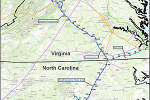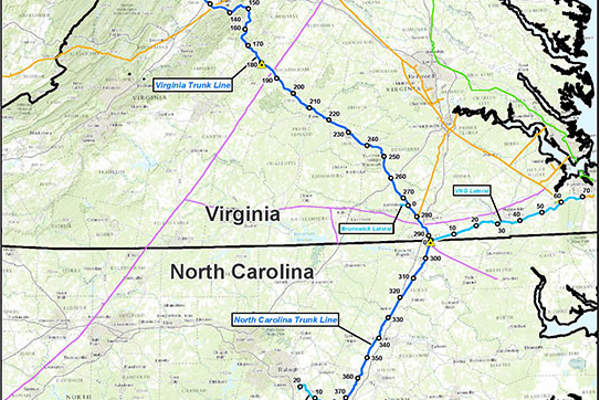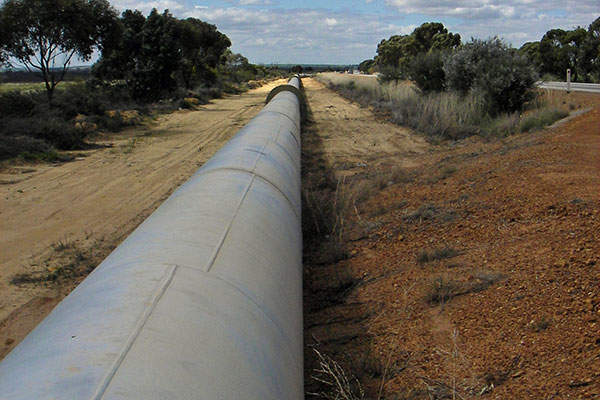Atlantic Coast Pipeline is a proposed 564.1-mile (907.8km) long, interstate natural gas transmission pipeline system that will fulfil the growing energy needs in Virginia (VA) and North Carolina, US.
The project will be developed, owned and operated by Atlantic Coast Pipeline (Atlantic), a joint venture of four American energy companies, Dominion Resources (45%), Duke Energy Corporation (40%), Piedmont Natural Gas (10%) and AGL Resources (5%).
The pipeline will have a capacity of 1.5 million metric dekatherms a day (1.5 billion cubic feet a day) of natural gas and is estimated to cost between $4.5bn and $5bn.
An application for the project was submitted to the US Federal Energy Regulatory Commission (FERC or Commission) on 18 September 2015. The FERC approved the certificate of public convenience and necessity for the project in October 2017.
Running through the regions of West Virginia, Virginia and North Carolina, the pipeline will enhance the local economy and also provide natural gas to generate electricity, heat homes and run local businesses by supplying these areas with Marcellus shale gas from West Virginia.
Dominion Transmission was contracted to oversee the construction and operation of the project on behalf of the Atlantic JV.
Construction on the project is expected to be completed between 2017 and 2019, while operations are expected to begin by the end of 2019.
Route details of Atlantic Coast pipeline
Beginning at Harrison County in West Virginia, the pipeline will run southeast through Virginia and extend to Chesapeake, VA, and further south through North Carolina to Robeson County.
An absence of existing pipeline infrastructure in West Virginia, Virginia and North Carolina prompted the proposed pipeline to be developed along a new corridor.
Approximately 497.4 miles (88%) of the pipeline will be built in a greenfield corridor, whereas the remaining 66.2 miles (12%) will run parallel to available linear corridor facilities that include pipelines, electric transmission lines, roads, railroads and a former surface strip mine.
The route changes were submitted to FERC to avoid environmental impacts in October 2015. The adjustments include Cheat Mountain route variation, Cow Knob route variation, the Warminster/Swift Island route variation, and the Great Dismal Swamp Major route alternative.
Details of Atlantic Coast pipeline
The project will consist of two new mainlines, namely AP-1 and AP-2, three new lateral pipelines AP-3, AP-4 and AP-5, three compressor stations, nine metering and regulating stations, 30 valves, eight sets of pig launcher and receiver assemblies, and associated appurtenances.
A 42in-diameter pipeline will be built in West Virginia and Virginia, a 36in-diameter pipeline will be constructed in North Carolina and a 20in-diameter pipeline will be in the extension to Hampton Roads.
The pipeline will have a maximum allowable operating pressure of 1,440lb per square inch gauge (psig). Taps will be fitted on the pipeline to provide access to larger customers.
Compressor stations along Atlantic Coast pipeline
The Rover Pipeline Project is a proposed interstate natural gas pipeline system that will transport natural gas to US and Canada from processing facilities located in the Marcellus and Utica shale areas.
Compressor station one, to be built in Lewis County, West Virginia, will supply natural gas from the proposed Kincheloe metering and regulating station to the mainline AP-1.
Comprising four gas driven turbines, the station will give a combined 55,015 horsepower (hp) of compression.
Compressor station two will be constructed in Buckingham County, Virginia, at the intersection of mainline AP-1 with Transco transmission pipelines.
The station will be bi-directional and will receive natural gas from both mainline AP-1 and existing Transco pipelines. It will also be able to discharge natural gas downstream into the mainline AP-1 and Transco pipelines. With four gas driven turbines, the station will provide 40,715hp of compression.
Compressor station three to be built in Northampton County, North Carolina, will be located at the intersection of the two mainlines and the lateral line one. It will supply natural gas from mainline AP-1 to mainline AP-2 and lateral AP-3. Consisting of three gas-driven compressors, the station will provide 21,815hp of compression.
Feed gas supply to the interstate natural gas pipeline
The proposed pipeline will receive natural gas from two new interconnections. One of them will be the Marts Junction Interconnection that will be established in Harrison County, West Virginia, between the Atlantic Coast Pipeline and Dominion transmission facilities.
The second interconnection will be the Buckingham Interconnect that will be located in Buckingham County, Virginia, between the Atlantic Coast Pipeline and existing Transco facilities.
Sale of gas from the Atlantic Coast Pipeline
Subsidiaries and affiliates of the four partners in the JV will be customers of the pipeline, while PSNC Energy has also signed a 20-year contract to off-take the gas.
Contractors involved
Dura-Bond was selected through a bidding process to provide steel pipes for the project in an agreement worth more than $400m. Pipes manufacturing commenced at Dura-Bond’s Steelton mill in late 2015.
Spring Ridge Constructors (SRC), a joint venture comprising Price Gregory International, Quanta Services, US Pipeline, SMPC, and Rockford Corporation, was awarded the lead construction contract in September 2016.






